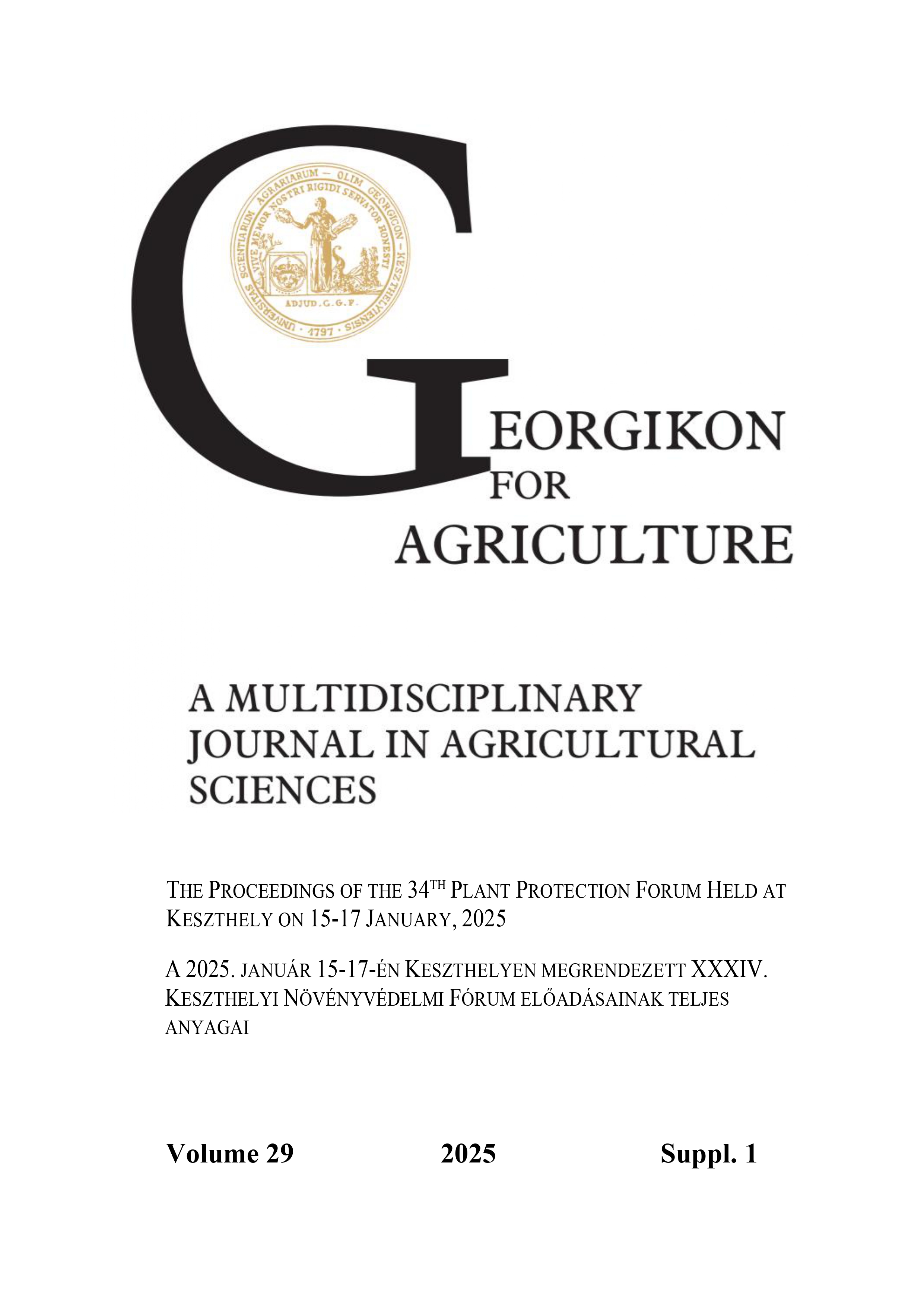Mesterséges intelligencia által vezérelt képfeldolgozó rendszer alkalmazása ürömlevelű parlagfű (Ambrosia artemisiifolia L.) pollenmérésére
DOI:
https://doi.org/10.70809/6570Kulcsszavak:
automatizált mérés, képi adatbázis, digitális képfeldolgozás, inváziós fajok, palinológia, modellképzés, mesterséges intelligencia, gépi tanulásAbsztrakt
Az ürömlevelű parlagfű (Ambrosia artemisiifolia) invazív gyomnövény, amelynek jól ismert a mezőgazdaságra és az egészségre gyakorolt negatív hatása. Munkánk során egy olyan mesterséges intelligencia alapú objektum felismerő modell kidolgozását tűztük ki célul, amely az általunk annotált képfelismerési adatbázist használja a pollenek méretének pontos meghatározására. Vizsgáltuk továbbá a pollenméret variabilitását eltérő morfológiai adottságokkal rendelkező egyedek között. A modell alkalmazása jelentősen leegyszerűsítette és felgyorsította a pollenmérés lassú és munkaigényes folyamatát. A hagyományos képelemző módszerekkel összehasonlítva, a Roboflow-alapú feldolgozás néhány milliszekundumra csökkenti a mérési időt. A repeatabilitás tesztelésekor, ugyanazt a pollent többször lemérve nagyon hasonló eredményt kaptunk, ami alapján kijelenthető, hogy a módszer alkalmas a pollenek méretének megbízható számszerűsítésre. Eredményeink egyedspecifikus összefüggést mutattak ki a pollenek méretében, ami mögött vélhetően trade-off kapcsolat állhat a növény növekedése és reprodukciója között. A jövőben érdemes lehet összefüggéseket keresni a morfológiai megjelenés és a pollen mennyisége és minősége között. A módszer és a belőlük származó kezdeti eredmények értékes kutatási potenciállal bír a növénybiológia vagy az ökológia területén, a növény-kórokozó kölcsönhatások további vizsgálatához, valamint a közegészségügyi vonatkozású kutatásokhoz. Ez az innovatív módszer fontos eszközként szolgálhat a pollenek monitorozásához és más morfológiai kutatásokhoz, amely eredmények nagy érdeklődésre tarthatnak számot multidiszciplináris alkalmazhatóságuk révén.
Hivatkozások
Bates, D., Mächler, M., Bolker, B. and Walker, S. 2015. Fitting linear mixed-effects models using lme4. Journal of Statistical Software. 67 (1) 1–48. https://doi.org/10.18637/jss.v067.i01
Buttenschøn, R., Waldispühl, C. B. 2010. Guidelines for management of common ragweed, Ambrosia artemisiifolia. http://www.EUPHRESCO.org
Costa, C. M. and Yang, S. 2009. Counting pollen grains using readily available, free image processing and analysis software. Annals of Botany. 104 (5) 1005–1010. https://doi.org/10.1093/aob/mcp186
Dwyer, B., Nelson, J., Hansen, T. et al. 2024. Roboflow (Version 1.0) [Software]. In https://roboflow.com
Hadfield, J. D. 2010. MCMC methods for multi-response generalized linear mixed models: the MCMCglmm R package. Journal of Statistical Software. 33 (2) 1–22. https://doi.org/10.18637/jss.v033.i02
Kocsis, I., Petróczy, M., Takács, K. Z. and Markó, G. 2022. Stimulation role of pollen grains in the initial development of Botrytis cinerea: The importance of host compatibility, cultivation status and pollen size. Journal of Phytopathology. 170 (11–12) 828–837. https://doi.org/10.1111/jph.13149
Langford, M., Taylor, G. E. and Flenley, J. R. 1990. Computerized identification of pollen grains by texture analysis. Review of Palaeobotany and Palynology. 64 (1) 197–203. https://doi.org/10.1016/0034-6667(90)90133-4
Leiblein-Wild, M. C., Kaviani, R. and Tackenberg, O. 2014. Germination and seedling frost tolerance differ between the native and invasive range in common ragweed. Oecologia. 174 (3) 739–750. https://doi.org/10.1007/s00442-013-2813-6
Nakahara, T., Fukano, Y., Hirota, S. K. and Yahara, T. 2018. Size advantage for male function and size-dependent sex allocation in Ambrosia artemisiifolia, a wind-pollinated plant. Ecology and Evolution. 8 (2) 1159–1170. https://doi.org/https://doi.org/10.1002/ece3.3722
Rodrigues, C., Barbosa Goncalves, A., Silva, G. and Pistori, H. 2015. Evaluation of Machine Learning and Bag of Visual Words Techniques for Pollen Grains Classification. IEEE Latin America Transactions. 13 3498–3504. https://doi.org/10.1109/TLA.9907
Sam, S., Halbritter, H. and Heigl, H. 2020. Ambrosia artemisiifolia PalDat - A palynological database. https://www.paldat.org/pub/Ambrosia_artemisiifolia/304617
Taramarcaz, P., Lambelet, B., Clot, B., Keimer, C. and Hauser, C. 2005. Ragweed (Ambrosia) progression and its health risks: Will Switzerland resist this invasion? Swiss medical weekly. 135 538–548. https://doi.org/10.4414/smw.2005.11201
Van Wychen, L. 2017. 2017 Survey of the Most Common and Troublesome Weeds in Broadleaf Crops, Fruits, and Vegetables. https://wssa.net/wp-content/uploads/2017-Weed-Survey_Grass-crops.xlsx
Vaudo, A. D., Tooker, J. F., Patch, H. M., Biddinger, D. J., Coccia, M., Crone, M. K., Fiely, M., Francis, J. S., Hines, H. M., Hodges, M., Jackson, S. W., Michez, D., Mu, J., Russo, L., Safari, M., Treanore, E. D., Vanderplanck, M., Yip, E., Leonard, A. S. and Grozinger, C. M. 2020. Pollen Protein: Lipid Macronutrient Ratios May Guide Broad Patterns of Bee Species Floral Preferences. Insects. 11 (2). 132. https://doi.org/10.3390/insects11020132
Letöltések
Megjelent
Folyóirat szám
Rovat
License
Copyright (c) 2025 Scherman Jakab Máté, Petróczy Marietta, Szathmáry Erzsébet, Markó Gábor

This work is licensed under a Creative Commons Attribution-NonCommercial-NoDerivatives 4.0 International License.
The articel is under the Creative Commons 4.0 standard licenc: CC-BY-NC-ND-4.0. Under the following terms: You must give appropriate credit, provide a link to the license, and indicate if changes were made. You may do so in any reasonable manner, but not in any way that suggests the licensor endorses you or your use. You may not use the material for commercial purposes. If you remix, transform, or build upon the material, you may not distribute the modified material. You may not apply legal terms or technological measures that legally restrict others from doing anything the license permits.




 Georgikon for Agriculture
Georgikon for Agriculture